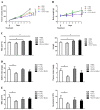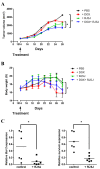Ruanjian Sanjie decoction exhibits antitumor activity by inducing cell apoptosis in breast cancer
- PMID: 28529560
- PMCID: PMC5431657
- DOI: 10.3892/ol.2017.5832
Ruanjian Sanjie decoction exhibits antitumor activity by inducing cell apoptosis in breast cancer
Abstract
Traditional Chinese medicine, based on theories developed and practiced for >2,000 years, is one of the most common complementary and alternative types of medicine currently used in the treatment of patients with breast cancer. Ruanjian Sanjie (RJSJ) decoction, is composed of four herbs, including Ban xia (Pinellia ternata), Xia ku cao (Prunella vulgaris), Shan ci gu (Cremastra appendiculata) and Hai zao (Sargassum pallidum), and has traditionally been used for softening hard lumps and resolving hard tissue masses. However, the active compounds and mechanisms of action of RJSJ remain unknown. The present study demonstrated the antitumor activity of RJSJ against Ehrlich ascites carcinoma in Swiss albino mice and breast cancer xenografts in nude mice. Notably, RJSJ does not induce body weight loss, immune function toxicity or myelosuppression in mice, indicating that it is safe and well tolerated. In addition, RJSJ shows potent cytotoxicity against breast cancer cells in vitro by the suppression of the anti-apoptotic proteins B-cell lymphoma 2 and survivin, leading to the activation of caspase-3/7 and caspase-9, and the apoptotic cascade. These findings provide a clear rationale to explore the therapeutic strategy of using RJSJ alone or in combination with chemotherapeutic agents for breast cancer patients and the characterization of its active principles.
Keywords: Ehrlich ascites carcinoma; Ruanjian Sanjie decoction; antitumor; apoptosis; breast cancer.
Figures




Similar articles
-
Tumor apoptosis induced by epoxide-containing piperazines, a new class of anti-cancer agents.Cancer Chemother Pharmacol. 2000;45(3):183-91. doi: 10.1007/s002800050028. Cancer Chemother Pharmacol. 2000. PMID: 10663635
-
[Effects of Xiaotan Sanjie Decoction-containing serum on proliferation and apoptosis of human gastric cancer cells MKN-45].Zhong Xi Yi Jie He Xue Bao. 2010 Mar;8(3):250-5. doi: 10.3736/jcim20100309. Zhong Xi Yi Jie He Xue Bao. 2010. PMID: 20226147 Chinese.
-
[In vivo and in vitro anti-tumor effect of Sanjie Kangliu Decoction].Nan Fang Yi Ke Da Xue Xue Bao. 2006 Apr;26(4):479-82. Nan Fang Yi Ke Da Xue Xue Bao. 2006. PMID: 16624758 Chinese.
-
Antitumor Efficacy of Huqizhengxiao (HQZX) Decoction Based on Inhibition of Telomerase Activity in Nude Mice of Hepatocarcinoma Xenograft.Integr Cancer Ther. 2018 Dec;17(4):1216-1224. doi: 10.1177/1534735418785999. Epub 2018 Jul 6. Integr Cancer Ther. 2018. PMID: 29978739 Free PMC article.
-
Inhibition of Nrf2 promotes the antitumor effect of Pinelliae rhizome in papillary thyroid cancer.J Cell Physiol. 2019 Aug;234(8):13867-13877. doi: 10.1002/jcp.28069. Epub 2019 Jan 30. J Cell Physiol. 2019. PMID: 30697724
Cited by
-
Enhancing Seed Germination of Cremastra appendiculata: Screening and Identification of Four New Symbiotic Fungi in the Psathyrellaceae Family.J Microbiol. 2024 Aug;62(8):671-682. doi: 10.1007/s12275-024-00148-7. Epub 2024 Jun 28. J Microbiol. 2024. PMID: 38940992
-
An in vivo and in vitro assessment of the anti-breast cancer activity of crude extract and fractions from Prunella vulgaris L.Heliyon. 2022 Oct 19;8(11):e11183. doi: 10.1016/j.heliyon.2022.e11183. eCollection 2022 Nov. Heliyon. 2022. PMID: 36345524 Free PMC article.
-
Compound Opening Arrow Mixture exerts anti-tumor effects in a mouse model of breast cancer.Sci Rep. 2020 May 18;10(1):8175. doi: 10.1038/s41598-020-64561-9. Sci Rep. 2020. PMID: 32424152 Free PMC article.
-
Screening of endophytic fungi from Cremastra appendiculata and their potential for plant growth promotion and biological control.Folia Microbiol (Praha). 2023 Feb;68(1):121-133. doi: 10.1007/s12223-022-00995-0. Epub 2022 Aug 19. Folia Microbiol (Praha). 2023. PMID: 35982376
-
Research progress on the anti-cancer mechanisms of edible salty-flavored Chinese materia medica.Front Pharmacol. 2025 Jun 20;16:1598978. doi: 10.3389/fphar.2025.1598978. eCollection 2025. Front Pharmacol. 2025. PMID: 40620671 Free PMC article. Review.
References
-
- Cohen SM, Mukerji R, Cai S, Damjanov I, Forrest ML, Cohen MS. Subcutaneous delivery of nanoconjugated doxorubicin and cisplatin for locally advanced breast cancer demonstrates improved efficacy and decreased toxicity at lower doses than standard systemic combination therapy in vivo. Am J Surg. 2011;202:646–653. doi: 10.1016/j.amjsurg.2011.06.027. - DOI - PMC - PubMed
LinkOut - more resources
Full Text Sources
Other Literature Sources
Research Materials
